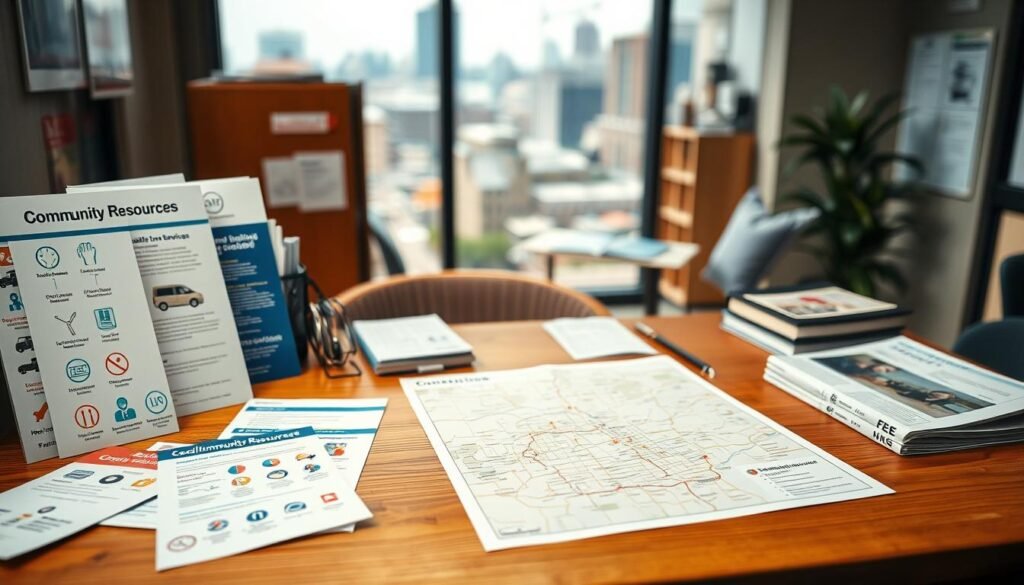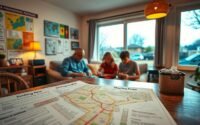Caring for Vulnerable Populations: Elderly & Disabled Evacuation Protocols
Have you ever wondered whether your household plan truly protects everyone when a disaster hits? This short guide puts plain steps on your kitchen table so you can act with confidence when an emergency arrives.
Start with what matters: use trusted resources—National Organization on Disability tips, FEMA and Red Cross checklists, and CERT-LA tools—to build clear, family-centered plans. These sources make complex planning simple and actionable.
Complete the SPEAK Unlimited Premise Alert Request Form and share it with local response teams. Add device power plans, transportation options, and shelter access notes so every person in your home has a known role.
Bookmark this guide. You’ll get printable templates, step-by-step checklists, and updates that keep your household ready for any disaster event.
Key Takeaways
- Use vetted resources (NOD, FEMA, Red Cross, CERT-LA) to start planning.
- File person-specific alerts like the SPEAK form with local police.
- Focus on communication, medication, power, and transport needs.
- Make roles clear to every adult and teen in the home.
- Keep quick-reference sheets and update plans quarterly.
- Bookmark this guide for regular updates, templates, and checklists.
Plan with Purpose: Family-Centered Preparedness Mindset
Start your household plan by naming who you protect and why. That purpose keeps planning practical and focused on the people in your home.
Make it routine. Pick one day a month to review community risks, update contact information, and run two simple steps like checking go-bags or shutoff valves.
- Assign roles that match abilities—who checks meds, who manages mobility gear, who grabs go-bags.
- Map likely events in your area and set clear triggers so you act fast during emergencies.
- Keep a short visible list inside a cabinet with the top 3–5 immediate actions.
Practice low-stress drills with timers and brief “what-if” scenarios so steps become second nature. Choose supportive neighbors and share a one-page summary of your plans and special needs.
| Role | Who | Primary Steps |
|---|---|---|
| Medication Lead | Adult A | Check supply, pack 3-day meds |
| Mobility Gear | Adult B | Secure devices, charge batteries |
| Communications | Teen | Update contacts, alert contacts |
| Backup Contact | Neighbor | Receive overview, assist if needed |
Use FEMA and Red Cross resources to adapt checklists. For a detailed response review, see the response workshop. Treat preparedness as an act of care that protects health and independence at every event.
Build Your Household Evacuation Plan Step by Step
Begin with a simple communications tree and two clear meeting places everyone can find.
Create a two-tier communications system: set up a group text and a phone call chain so people stay linked if one method fails. Pick two meeting places—a nearby spot and an out-of-neighborhood address—and print those locations on wallet cards.
File the SPEAK Unlimited Premise Alert Request Form with local police so first responders get person-specific instructions. Carry one-page person sheets for each household member listing diagnoses, medications (brand and generic), allergies, assistive devices, and emergency contacts.
Store printed health records and insurance cards in waterproof sleeves inside go-bags and with a traveler’s wallet. Practice your plan in stages: tabletop walkthrough, timed drill, then a full exit with transfers, device packing, and loading into transportation.
Use checklists from Red Cross, FEMA, and CERT-LA to confirm supplies like spare glasses, hearing aid batteries, and chargers. Keep laminated copies of the plan near exits and email PDFs to trusted neighbors, aides, and staff so response is fast if someone arrives first.
Quick reference
| Action | Who | Where | Notes |
|---|---|---|---|
| Communications tree | Family lead & teen | Group text + call chain | Test monthly |
| Person sheet | Caregiver | Wallet & go-bag | Include meds list |
| Premise alert | Primary contact | Local police file | List mobility aids |
| Practice drill | All household people | Home & meeting place | Run quarterly |
Stock Smart: Medical, Power, and Disaster Supplies Kits
Put medication and temperature-sensitive items at the top of your packing list: keep a clearly labeled 3–6 day supply of prescriptions and an insulated carrier with frozen ice packs for insulin or other refrigerated meds.
Assemble a practical medication module. Include up-to-date med lists with generic names, a printed treatment summary, and extra doses where possible. Add a glucometer and strips, a blood pressure cuff, hearing aids with spare batteries, spare eyeglasses, and denture care items.
Build a tailored disaster kit
Store at least one gallon of water per person per day for three days, nonperishable foods your family will eat, a manual can opener, and a first aid kit per Red Cross guidance.
Plan power and assistive tech
Include wall chargers, a labeled battery bank, and a small solar charger if feasible. Use June Isaacson Kailes’ power planning checklist to map runtimes and backup options for wheelchairs, ventilators, or feeding pumps.
- Keep vital records in a slim waterproof folder in every kit and a caregiver bag.
- Stage kits by the main exit and in your vehicle so essentials travel with you.
- Tailor items to mobility, hearing, sensory, and cognitive needs—large-print cards, tactile labels, and transfer aids.
- Review and rotate supplies quarterly; set calendar reminders to replace meds and batteries.
Bookmark this guide to get printable checklists and updated power-planning resources as we refine our supply lists and templates.
Evacuation Logistics: Transportation, Shelters, and Reasonable Accommodations
Decide now who will drive, who will be your backup, and how you’ll reach them if phones fail.
Set clear ride roles. Name a primary driver and at least one alternate. Choose two meeting places and store printed maps in your glove box.
Preload local routes on your phone and call county offices to confirm which shelters accept service animals and companion caregivers. Pack documentation of medical and mobility needs to speed conversations with shelter staff.
Bring chargers, labeled meds, and a 72-hour supply so you can stay as independent as possible while shelter managers arrange support.
Printable checklist
- Primary driver, backup driver, and contact method
- Printed evacuation routes and meeting place cards
- Documentation: meds, diet, communication preferences
- Service animal info and caregiver contact
| Item | Who | Why | Notes |
|---|---|---|---|
| Driver list | Family lead | Reliable transportation | Include offline contact method |
| Shelter contact | Caregiver | Confirm accommodations | Ask about staff support |
| Device specs | Individual | Safe transport & charging | Measure dimensions, tie-down needs |
Bookmark this page so you can check local transportation and shelter guidance when your community issues a response.
Caring for Vulnerable Populations: Elderly & Disabled Evacuation Protocols
Make communication plans that reach people where they are — in shelters, cars, motels, and on the street.
Outreach must begin before disaster strikes and continue during response. Use trusted community networks like Continuums of Care, outreach teams, and EMTs to deliver short, practical messages.
Communication access: hearing, visual, and complex communication needs
Prepare accessible materials in advance: large print, pictograms, plain language, and translated instructions. Preload AAC devices with disaster vocabulary and print Temple University’s displays in English, Spanish, and Haitian.
For hearing access, include visual alert cards, write-on slates, and vibration alerts. Keep pocketable lists of key phrases and requests staff can use instantly.
Reaching people with limited access: trusted networks and simple messages
Use outreach workers, EMTs, and service providers who already have rapport. Keep messages short and practical: pickup spots, pet policies, what to bring, and likely duration.
- Distribute weather-resistant handouts and repeat visits as urgency grows.
- Anticipate issues like battery saving, fear of enforcement, and concern for belongings; address them directly.
- Train family, aides, and outreach staff on simple scripts and door-to-door checks.
Close the loop after a disaster with clear all-clear notes and directions for med refills and follow-up care. Bookmark this guide for ongoing resources and updates.
Know Your Rights and Local Resources
Start by learning what federal and local laws guarantee when you ask for accessible help during an emergency.
Know the basics of the ADA so you can request accessible shelters, transportation, and communications without delay. Call the ADA info-line if a site blocks access and carry a one-page summary of your accommodation needs to speed on-site discussions.
Use official guides to back your requests. Share “An ADA Guide for Local Governments” with local emergency managers and use NOD’s planning guide to push for inclusive drills at senior centers, schools, or HOA meetings.

Quick list of practical next steps
- Keep a taped master list of local disability offices, paratransit, and shelter hotlines.
- Print highlights from “Breaking Through the Barriers” to show shelter staff examples of reasonable accommodations.
- Build a binder with NFPA, UC Berkeley, Red Cross, FEMA, and Inclusive Preparedness Center guides and update it yearly.
- Document any issues and follow up in writing with local managers to improve future response.
| Resource | Use | Contact | Notes |
|---|---|---|---|
| ADA info-line | Rights & enforcement | National hotline | Call if shelters deny access |
| NOD guide | Inclusive planning | Emergency managers | Share with local planners |
| Red Cross / FEMA | Shelter & preparedness | Local chapters | Find tailored guides for adults and families |
| Area Agency on Aging | Local support | State office | Vouchers, registries, transport |
Make sure your family knows these resources before a disaster so you can focus on safety, not negotiation.
Conclusion
End your planning session by printing a one-page summary that fits in wallets, glove boxes, and every go-bag.
Recap: pack a 3–6 day med supply in insulated storage, keep a communication tree plus two meeting places, and file the Premise Alert Request Form with first responders.
Include shelter accommodation guides, power planning checklists for assistive devices, and ADA resources so your team can meet each person’s needs. Share the plan with neighbors and your community to speed help during a disaster.
Make sure you revisit the plan quarterly, rotate meds and batteries, and practice timed drills. Bookmark this page and return often—updates keep your emergency preparedness current and useful to the people you protect.
FAQ
How do I start a family-centered preparedness plan?
Begin by listing each person’s health needs, mobility limits, and communication preferences. Pick two meeting spots (one near home, one outside the neighborhood) and build an emergency communications tree with phone numbers, email, and a backup contact. Practice the plan with everyone every six months and update contacts and medications as things change.
What should go on a person-specific info sheet for first responders?
Include full name, photo, emergency contacts, primary doctor, allergies, current medications with dosages, medical devices, mobility aids, cognitive notes, and preferred language or communication methods. Attach a copy to your front door or register it with local programs such as the Premise Alert Request Form so responders see it quickly.
How much medication should I pack and how do I keep refrigerated meds safe?
Aim for a 3–6 day supply in your evacuation kit. Keep refrigerated meds in insulated containers with freezer packs and a thermometer. Store copies of prescriptions and prescriber contact info in a waterproof folder so you can refill if needed.
What essential medical equipment and backups should I include?
Pack spare batteries, chargers, repair kits, and replacement parts for devices like CPAP machines, oxygen concentrators, mobility scooters, hearing aids, and insulin pumps. Include written instructions for setup and a list of vendors who can supply emergency repairs.
How do I tailor a disaster supplies kit to mobility or sensory needs?
Add items that support independence: transfer belts, slip-on shoes, extra walkers or canes, tactile labels, noise-canceling headphones, large-print instructions, and familiar comfort items that reduce stress. Organize items in easy-to-grab containers and label them clearly.
What should I know about transportation options during an evacuation?
Map several routes out of your area and identify accessible pickup points. Arrange a primary ride with family or a neighbor and a backup with local transit paratransit, nonemergency medical transport, or the Red Cross. Keep vehicle adaptive equipment in the car and a plan for transferring from a home to a vehicle safely.
How do shelters handle accessibility and reasonable accommodations?
Shelters must provide reasonable accommodations under the ADA. Bring documentation of needs, service animal paperwork, and a caregiver plan if you require assistance. Contact the shelter ahead if possible to request a private area, mobility-accessible space, or communication support.
Can service animals stay with their handlers at shelters?
Yes. Service animals are allowed in shelters, but you should carry documentation, a leash, and basic care supplies such as food, water, and a recent photo. Emotional support animals may have different rules, so check shelter policies before arrival.
How can I ensure effective communication for people who are deaf, hard of hearing, or nonverbal?
Prepare written notes that explain communication needs, preferred methods (text, sign language, picture cards), and interpreter contact info. Register for local alert systems that offer text or TTY messages and bring personal amplifiers, hearing aid batteries, or speech-generating devices.
What simple messaging works best to reach people with limited access?
Use short, clear instructions with one action per sentence. Repeat critical details and include visuals when possible. Rely on trusted networks—faith groups, community centers, neighbors, and case managers—to spread messages and confirm safety.
What are my rights under the ADA during emergencies?
The ADA requires public entities and shelters to provide reasonable modifications and accessible services during emergencies. You can request accommodations, ask for an accessible shelter space, and seek assistance with transportation. Document your requests and follow up with local emergency management if needs aren’t met.
Where can I find local government and nonprofit resources tailored to seniors and people with disabilities?
Start with your city or county emergency management office, the Department of Health and Human Services, and the local Area Agency on Aging. National organizations like FEMA, the American Red Cross, and the National Council on Aging offer guides and printable checklists. Keep a list of local disability services, veterans’ organizations, and aging coalitions in your emergency folder.
How often should I update my plan and supplies?
Review your plan and supplies every six months or whenever medications, health status, or household composition changes. Check expiration dates on supplies, replace batteries, and rehearse evacuation routes and communications during seasonal drills.


